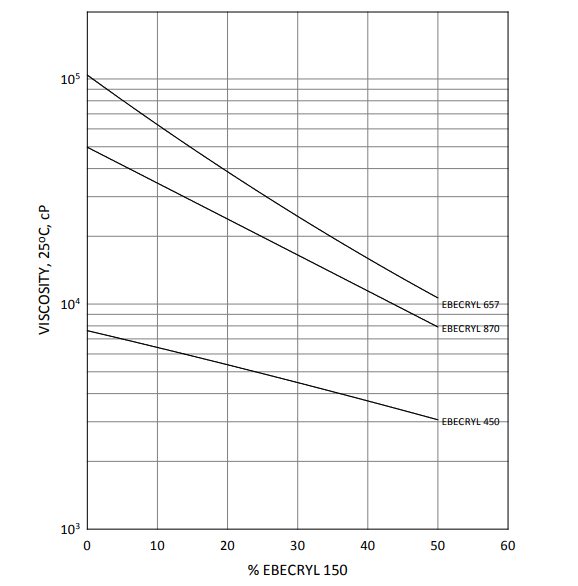Enhanced TDS
Identification & Functionality
- CASE Ingredients Functions
- Chemical Family
- Chemical Name
- Country of Origin
- Function
- Reactive Diluent
- Product Code
- MITM00355
- Technologies
- Product Families
- Chemical Structure

Features & Benefits
- CASE Ingredients Features
- Product Features
EBECRYL® 150 is characterized by:
- High reactivity
- Moderate viscosity
- High refractive index
UV/EB curable formulated products containing EBECRYL® 150 are characterized by:
- Hardness
- Chemical resistance
- Good adhesion
- Improved wetting
The actual properties of UV/EB cured products also depend on the selection of other formulation components such as oligomers, additives and photoinitiators.
Applications & Uses
- Coating End Applications
- Cure Method
- Ink & Toner End Applications
- Markets
- Applications
- Product Applications
- Printing inks
- Low viscosity, high refractive index coatings
- Product Applications
EBECRYL® 150 is recommended as a reactive diluent for UV/EB cured offset inks, silk screen inks, overprint varnishes and coatings. Effective levels of EBECRYL® 150 typically range from 10% to 50% depending on the application.
EBECRYL® 150 is recommended for use in:
- Printing inks
- Low viscosity, high refractive index coatings
Properties
- Physical Form
Technical Details & Test Data
- Viscosity Reduction
Graph shows the viscosity reduction of the lithographic ink vehicles EBECRYL 450(1), EBECRYL 657(1) and EBECRYL 870(1) when blended with EBECRYL® 150.

Dilution effect of ebecryl 150 on viscous oligomers
Packaging & Availability
Principal Information
- Group Principal Number
- S000001
- Principal
Storage & Handling
- Storage Conditions
- Care should be taken not to expose the product to high temperature conditions, direct sunlight, ignition sources, oxidizing agents, alkalis or acids.
- This might cause uncontrollable polymerization of the product with the generation of heat.
- Storage and handling should be in stainless steel, amber glass, amber polyethylene or baked phenolic lined containers.
- Procedures that remove or displace oxygen from the material should be avoided.
- Do not store this material under an oxygen free atmosphere.
- Dry air is recommended to displace material removed from the container.
- Wash thoroughly after handling.
- Keep container tightly closed.
- Use with adequate ventilation.
Other
- Appearance
- Clear liquid
- Appearance (SDS)
- Clear viscous liquid
- Color (SDS)
- Amber
- IATA/ICAO Proper Shipping Name
- Environmentally hazardous substance, liquid, N.O.S.
- IATA/ICAO Technical name (N.O.S.)
- Acrylated resin
- IATA/ICAO UN Number
- UN3082
- IMO/IMDG Proper Shipping Name
- Environmentally hazardous substance, liquid, N.O.S.
- IMO/IMDG Technical name (N.O.S.)
- Acrylated resin
- IMO/IMDG UN Number
- UN3082
- Item Number
- Odor (SDS)
- Acrylate
- Other Hazards
- Polymerization may occur from excessive heat, contamination or exposure to direct sunlight, Contact with skin may cause a cross-allergic reaction in persons already sensitized to acrylates.
- Protect from Freezing
- Yes
- TDG Canada Proper Shipping Name
- Environmentally hazardous substance, liquid, N.O.S.
- TDG Canada Technical name (N.O.S.)
- Acrylated resin
- TDG Canada UN Number
- UN3082
- Temperature Control
- Yes
- USA/DOT Proper Shipping Name
- Environmentally hazardous substance, liquid, N.O.S.
- USA/DOT Technical name (N.O.S.)
- Acrylated resin
- USA/DOT UN Number
- UN3082
- Application Information
Value Units Test Method / Conditions Dosage (Use Level) 10.0-50.0 % % - Chemical Properties
Value Units Test Method / Conditions Acid Value max. 5.0 mg KOH/g mg KOH/g - Mechanical Properties
Value Units Test Method / Conditions Elongation 9.0 % % UV cured 125 µ thick films Tensile Modulus 180000.0 psi psi Dynamic Mechanical Analysis (DMA) UV cured 125 µ thick films Tensile Strength 6300.0 psi psi UV cured 125 µ thick films - Optical Properties
Value Units Test Method / Conditions Color Scale max. 2.0 Gardner Gardner Gardner Color Scale Refractive Index 1.5294 - at 20°C, nD - Physical Properties
Value Units Test Method / Conditions Density 1.14 g/mL g/mL at 25°C Flash Point min. 100.0 °C °C Setaflash Glass Transition Temperature (Tg) 41.0 °C °C Dynamic Mechanical Analysis (DMA) UV cured, 125μm thick films Glass Transition Temperature (Tg) 41.0 °C °C UV cured 125 µ thick films Storage Temperature 39.0-104.0 °F °F Vapor Pressure max. 0.01 mm Hg mm Hg at 20°C Viscosity 1150.0-1650.0 mPa.s mPa.s at 25°C - SDS Physical and Chemical Properties
Value Units Test Method / Conditions Boiling Point (SDS) min. 100.0 °C °C Density (SDS) 1.14 g/cm³ g/cm³ Solubility In Water (SDS) 0.23 mg/L mg/L at 25°C Vapor Pressure (SDS) max. 1.33 hPa hPa at 20°C Volatile Content (SDS) max. 0.3 % % - Shelf Life & Stability
Value Units Test Method / Conditions Shelf Life 0.0 d d
